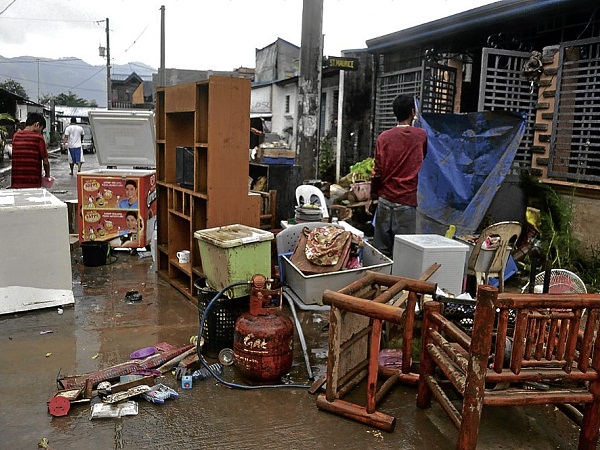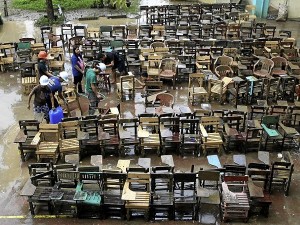Stakeholders offer tips on restoration, cleanup

RESIDENTS of Rodriguez, Rizal, salvage whatever’s left of their belongings after a flash flood. ARNOLD ALMACEN
After the rains have stopped, the skies have cleared, and floods have subsided, a bigger and more daunting predicament may give homeowners another reason to worry.
The cleanup and restoration of affected (or at most, devastated) houses are among the more grueling tasks that homeowners have to face in the aftermath of the devastation wrought by natural typhoons, such as the torrential rains poured by the recent monsoon.
It is, however, important to keep in mind a number of things that should be at your priority list and to follow certain guidelines to ensure that all efforts geared toward cleaning up and salvaging whatever’s left of your property will not be in vain.
To help homeowners in such process, Inquirer Property had polled several stakeholders from the property and other related sectors to lend their expertise as to what should be done in the aftermath of the storms and floods. Here is what they have to say:
“Check all electrical outlets [to ensure that these] are dry before switching the main power source! Grounded electrical connection may cause fatal electric shock or fire! For cleaning, check storm drainage for clogs and debris [and clean it up to] spare your house to be flooded even due to light rains if your storm drainage has not been cleaned.
“For the structure, check if there are parts [within your lot] that [have eroded or scoured as this may result in] unstable ground.” —Engineer Gil Carsido, Megaworld Corp.
“Most structures have foundations that sit on adobe bedrock, and thus, should not be affected. Other systems added to the structure like ceilings, paneling and cabinetry should be checked by an experienced contractor, as they may have absorbed water and their fixings may have weakened and could cause the fixtures to dislodge or collapse.
“You will need to open all the power outlets that were submerged and flush out any remaining floodwater with air. An air compressor with a hose—like what painters use—will do the trick. After flushing out with air, leave it for a day or two without switching it on, so as to allow the outlets to dry thoroughly. Do not reinstall the plates until they have been dried out.
“If your main circuit breaker was submerged, you will have to do the same flushing for all the circuits, and possibly dismantle the wires and switches, wipe them dry, then reinstall.
“Wash down the floors and walls before the remaining silt in the floodwater dries and cakes on your floors. If you have wooden floors, try to dab a rag in their joints to try and remove any remaining water in between the planks or pieces. Wash down and dry out all your surfaces as the longer they are wet, the more they will suffer damage from the water.
“Wash down upholstery immediately. Use a disinfectant diluted in your wash water to kill germs and other organic matter. Foam cushions should be squeezed to extract any water within. For stains on stone finishes like marble or granite, try spreading on it a paste of baking soda and water, leave for half a day, then rinse off. The mud stains should come off.
“Allow wooden furniture to dry thoroughly for a week or two before sending it off for repair, as the timber will still be moving as it rids itself of excess moisture.”—Isabel Berenguer–Asuncion, principal architect, Asuncion Berenguer Inc. and Inquirer columnist
“Clean and sanitize all areas affected by the flood and make sure to dry up every nook. Use a strong bleach to clean then sanitize with Lysol as undried areas can breed molds.
“Check all floors and walls to make sure no floodwater remains. Check into wooden partitions or wall panels to dry up, but best to replace wood partitions with concrete walls. Replace wooden baseboards or prevent wood from absorbing water by refinishing in duco paint finish.
“Clean and dry wood furniture thoroughly, then refinish. Reupholster seating but make sure to replace all inner materials (foam and straps) to prevent molds from setting in. Throw away and replace mattresses submerged in floodwater—it is not worth keeping and cleaning.”—Alice Erfe, principal, Erfe & Associates and design consultant for Rockwell Land Corp.
“Regarding the furniture, you need to examine each piece and determine the extent of the damage. Then you separate the items that you feel can be saved and those that are not salvageable for insurance claims. Upholstered furniture that has been completely submerged in water for a long period of time is prone to mold and mildew, whereas wood furniture is prone to warping. Do keep this in mind when you start reorganizing your home after a flood.
“Move the furniture out of a wet, damp or extremely humid area to avoid further damage and facilitate drying. If the furniture is too bulky to move, try to place it on thick wood blocks so that it sits higher and away from a damp carpet or floor. If your pieces are muddy, rinse them off with clean water and dry in a ventilated place away from the sun.
“The furniture pieces need to be dried thoroughly. For those who have furniture without fixed upholstery, remove the loose cushions and fabrics and have them cleaned and dried separately to avoid bleeding of the fabric colors.
“Wood furniture needs to be wiped dry as soon as possible. To speed up the drying process, you may remove all parts of the wood furniture such as drawers. Only once the furniture has been completely dried can you start the restoration process. I recommend contacting the furniture manufacturer as they can service you with refurbishing and guide you as to what products to use if the damage is not extensive.”—Stephanie Kienle of Philux

